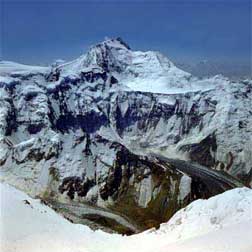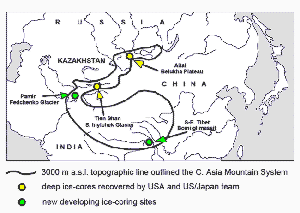The high elevation snowfields of the Pamir and Tien Shan contain robust records documenting: moisture advection into central Asia from the Atlantic and Arctic; dynamics of the westerly jet stream, the Siberian High, and Asian monsoon; and naturally and humanly forced environmental change over central Asia.
The current spatial coverage of ice-core records from the Altai, Tibet and the Himalaya is inadequate to document climatic and environmental changes over the northern region of central Asia through the Holocene, even though central Asian glaciers have been studied continuously since the 19th century by Russian scientists and despite the apparent sensitivity of this region to future climate change.
The Pamir are located in a region that influences hemispheric scale climate and is expected to experience major environmental change as a consequence of warming. Little past climate information exists from the Pamir and central Asia in general. Asia has a long history of diverse civilization and a large potential for dramatic impact by humans in the near future related to  land use, water demand, and general development of society.
land use, water demand, and general development of society.
This field season to the Fedchenko glacier in the Pamir will be a reconnaissance trip to sample snowpits, collect shallow (10 to 20 m) ice cores, and install a meteorological station. The purpose of this field season is to acquire additional information about the site to verify that the climate signal is preserved in the cores. The shallow cores that will be collected this summer will provide the necessary data to secure funding for the Central Asia Deep Ice-Coring Project (CADIP) from international funding agencies. CADIP is a multinational effort to drill a 500-1000 meter ice core, which will be the deepest non-polar ice core ever recovered, and will provide a climatic and environmental record covering the Holocene.
Institutions in addition to the University of Idaho and University of Maine involved with the project include the China Meteorological Administration; Cold and Arid Environmental Engineering Research Institute; Chinese Academy of Sciences; Tibetan Plateau Institute; Institute for Environmental Physics, University of Heidelberg; Institute of Environmental Geochemistry, University of Heidelberg; Research Institute of Humanity and Nature; Graduate School of Environmental Studies, Nagoya University; Zenralasiatisches Institut für Angewandte Geowissenschaften in Bischkek; Paul Scherrer Institut, Labor fur Radio- und Umweltchemie; Institute of Water Resources and Hydropower, Tajik Academy of Science; and Tomsk State University.


